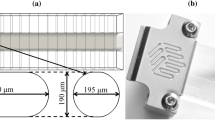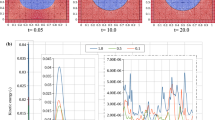Abstract
Computational modeling and theoretical simulations have recently become important tools for the development, characterization, and validation of microfluidic devices. The recent proliferation of commercial user-friendly software has allowed researchers in the microfluidics community, who might not be familiar with computer programming or fluid mechanics, to acquire important information on microsystems used for sensors, velocimetry, detection for microchannel separations, and microfluidic fuel cells. We discuss the most popular computational technique for modeling these systems—the finite element method—and how it can be applied to model electrochemical processes coupled with hydrodynamic flow in microchannels. Furthermore, some of the limitations and challenges of these computational models are also discussed.





Similar content being viewed by others
References
Reyes DR, Iossifidis D, Auroux PA, Manz A (2002) Micro total analysis systems. 1. Introduction, theory, and technology. Anal Chem 74:2623–2636
Auroux PA, Iossifidis D, Reyes D, Manz A (2002) Micro total analysis systems. 2. Analytical standard operations and applications. Anal Chem 74:2637–2652
Squires TM, Messinger RJ, Manalis SR (2008) Making it stick: convection, reaction and diffusion in surface-based biosensors. Nat Biotechnol 26:417–426
Boy DA, Gibou F, Pennathur S (2008) Simulation tools for lab on a chip research: advantages, challenges, and thoughts for the future. Lab Chip 8:1424–1431
Glatzel T, Litterst C, Cupelli C, Lindemann T, Moosmann C, Niekrawietz R, Streule W, Zengerle R, Koltay P (2008) Computational fluid dynamics (CFD) software tools for microfluidic applications—a case study. Comput Fluids 37:218–235
Zhang B, Zhang Y, White HS (2005) Steady-state voltammetric response of the nanopore electrode. Anal Chem 78:477–483
Zhang B, Zhang Y, White HS (2004) The nanopore electrode. Anal Chem 76:6229–6238
Zevenbergen MAG, Wolfrum BL, Goluch ED, Singh PS, Lemay SG (2009) Fast electron-transfer kinetics probed in nanofluidic channels. J Am Chem Soc 131:11471–11477
Zevenbergen MAG, Singh PS, Goluch ED, Wolfrum BL, Lemay SG (2009) Electrochemical correlation spectroscopy in nanofluidic cavities. Anal Chem 81:8203–8212
Zevenbergen MAG, Krapf D, Zuiddam MR, Lemay SG (2006) Mesoscopic concentration fluctuations in a fluidic nanocavity detected by redox cycling. Nano Lett 7:384–388
Kim E, Kim J, Amemiya S (2009) Spatially resolved detection of a nanometer-scale gap by scanning electrochemical microscopy. Anal Chem 81:4788–4791
Monson CF, Majda M (2007) Ion diffusion in channels containing random arrays of microspheres: an electrochemical time-of-flight method. Anal Chem 79:9315–9320
Zhang B, Adams KL, Luber SJ, Eves DJ, Heien ML, Ewing AG (2008) Spatially and temporally resolved single-cell exocytosis utilizing individually addressable carbon microelectrode arrays. Anal Chem 80:1394–1400
Guo J, Lindner E (2008) Cyclic voltammograms at coplanar and shallow recessed microdisk electrode arrays: guidelines for design and experiment. Anal Chem 81:130–138
Lin C-L, Rodriguez-Lopez J, Bard AJ (2009) Micropipet delivery-substrate collection mode of scanning electrochemical microscopy for the imaging of electrochemical reactions and the screening of methanol oxidation electrocatalysts. Anal Chem 81:8868–8877
Sinton D (2004) Microscale flow visualization. Microfluid Nanofluid 1:2–21
Williams S, Park C, Wereley S (2010) Advances and applications on microfluidic velocimetry techniques. Microfluid Nanofluid 8:709–726
Kjeang E, Roesch B, McKechnie J, Harrington D, Djilali N, Sinton D (2007) Integrated electrochemical velocimetry for microfluidic devices. Microfluid Nanofluid 3:403–416
Wu J, Sansen W (2002) Electrochemical time of flight flow sensor. Sens Actuators A 97–98:68–74
Wu J, Ye J (2005) Micro flow sensor based on two closely spaced amperometric sensors. Lab Chip 5:1344–1347
Wu J, Zhou Q, Liu J, Lou Z (2006) Simulation study of nano aqueous flow sensor based on amperometric measurement. Sensors 6:473–479
Thompson M, Compton RG (2007) Voltammetric monitoring of transient hydrodynamic flow profiles in microfluidic flow cells. Anal Chem 79:626–631
Amatore C, Klymenko OV, Oleinick AI, Svir I (2009) Electrochemical determination of flow velocity profile in a microfluidic channel from steady-state currents: numerical approach and optimization of electrode layout. Anal Chem 81:7667–7676
Woolley AT, Lao K, Glazer AN, Mathies RA (1998) Capillary electrophoresis chips with integrated electrochemical detection. Anal Chem 70:684–688
Xu J-J, Wang A-J, Chen H-Y (2007) Electrochemical detection modes for microchip capillary electrophoresis. TrAC Trends Anal Chem 26:125–132
Vandaveer WR, Pasas-Farmer SA, Fischer DJ, Frankenfeld CN, Lunte SM (2004) Recent developments in electrochemical detection for microchip capillary electrophoresis. Electrophoresis 25:3528–3549
Pumera M, Merkoçi A, Alegret S (2006) New materials for electrochemical sensing VII. Microfluidic chip platforms. TrAC Trends Anal Chem 25:219–235
Amatore C, Da Mota N, Sella C, Thouin L (2008) General concept of high-performance amperometric detector for microfluidic (bio)analytical chips. Anal Chem 80:4976–4985
Amatore C, Da Mota N, Sella C, Thouin L (2007) Theory and experiments of transport at channel microband electrodes under laminar flows. 1. Steady-state regimes at a single electrode. Anal Chem 79:8502–8510
Cooper JA, Compton RG (1998) Channel electrodes—a review. Electroanalysis 10:141–155
Cutress IJ, Dickinson EJF, Compton RG (2010) Analysis of commercial general engineering finite element software in electrochemical simulations. J Electroanal Chem 638:76–83
Amatore C, Da Mota N, Lemmer CI, Pebay CC, Sella C, Thouin L (2008) Theory and experiments of transport at channel microband electrodes under laminar flows. 2. Electrochemical regimes at double microband assemblies under steady state. Anal Chem 80:9483–9490
Amatore C, Da Mota N, Sella C, Thouin L (2010) Theory and experiments of transport at channel microband electrodes under laminar flow. 3. Electrochemical detection at electrode arrays under steady state. Anal Chem 82:2434–2440
Omiatek DM, Santillo MF, Heien ML, Ewing AG (2009) Hybrid capillary-microfluidic device for the separation, lysis, and electrochemical detection of vesicles. Anal Chem 81:2294–2302
Carlo DD, Ionescu-Zanetti C, Zhang Y, Hung P, Lee LP (2005) On-chip cell lysis by local hydroxide generation. Lab Chip 5:171–178
Ordeig O, Godino N, del Campo J, Munoz FX, Nikolajeff F, Nyholm L (2008) On-chip electric field driven electrochemical detection using a poly(dimethylsiloxane) microchannel with gold microband electrodes. Anal Chem 80:3622–3632
Seo J-H, Leow PL, Cho S-H, Lim H-W, Kim J-Y, Patel BA, Park J-G, O'Hare D (2009) Development of inlaid electrodes for whole column electrochemical detection in HPLC. Lab Chip 9:2238–2244
Wu X-Z, Huang T, Liu Z, Pawliszyn J (2005) Whole-column imaging-detection techniques and their analytical applications. TrAC Trends Anal Chem 24:369–382
Moehlenbrock M, Arechederra R, Sjoholm K, Minteer S (2009) Analytical techniques for characterizing enzymatic biofuel cells. Anal Chem 81:9538–9545
Wang C-Y (2004) Fundamental models for fuel cell engineering. Chem Rev 104:4727–4766
Dyer CK (2002) Fuel cells for portable applications. J Power Sources 106:31–34
Kjeang E, Djilali N, Sinton D (2009) Microfluidic fuel cells: a review. J Power Sources 186:353–369
Maynard HL, Meyers JP (2002) Miniature fuel cells for portable power: design considerations and challenges. J Vac Sci Technol B 20:1287–1297
Pennathur S, Eijkel J, van den Berg A (2007) Energy conversion in microsystems: is there a role for micro/nanofluidics? Lab Chip 7:1234–1237
Choban ER, Markoski LJ, Wieckowski A, Kenis PJA (2004) Microfluidic fuel cell based on laminar flow. J Power Sources 128:54–60
Bazylak A, Sinton D, Djilali N (2005) Improved fuel utilization in microfluidic fuel cells: a computational study. J Power Sources 143:57–66
Chen F, Chang M-H, Lin M-K (2007) Analysis of membraneless formic acid microfuel cell using a planar microchannel. Electrochim Acta 52:2506–2514
Chang M-H, Chen F, Fang N-S (2006) Analysis of membraneless fuel cell using laminar flow in a Y-shaped microchannel. J Power Sources 159:810–816
Chen W, Chen F (2006) Theoretical approaches to studying the single and simultaneous reactions in laminar flow-based membraneless fuel cells. J Power Sources 162:1137–1146
Zebda A, Renaud L, Cretin M, Innocent C, Pichot F, Ferrigno R, Tingry S (2009) Electrochemical performance of a glucose/oxygen microfluidic biofuel cell. J Power Sources 193:602–606
Togo M, Takamura A, Asai T, Kaji H, Nishizawa M (2008) Structural studies of enzyme-based microfluidic biofuel cells. J Power Sources 178:53–58
Yoon S, Choban E, Kane C, Tzedakis T, Kenis P (2005) Laminar flow-based electrochemical microreactor for efficient regeneration of nicotinamide cofactors for biocatalysis. J Am Chem Soc 127:10466–10467
Chen F, Chang M-H, Hsu C-W (2007) Analysis of membraneless microfuel cell using decomposition of hydrogen peroxide in a Y-shaped microchannel. Electrochim Acta 52:7270–7277
Lee J, Lim KG, Palmore GTR, Tripathi A (2007) Optimization of microfluidic fuel cells using transport principles. Anal Chem 79:7301–7307
Yoon SK, Fichtl GW, Kenis PJA (2006) Active control of the depletion boundary layers in microfluidic electrochemical reactors. Lab Chip 6:1516–1524
Sparreboom W, van den Berg A, Eijkel J (2010) Transport in nanofluidic systems: a review of theory and applications. New J Phys 12:015004
Napoli K, Eijkel J, Pennathur S (2010) Nanofluidic technology for biomolecule applications: a critical review. Lab Chip 10:957–985
Eijkel J, van den Berg A (2005) Nanofluidics: what is it and what can we expect from it? Microfluid Nanofluid 1:249–267
Acknowledgements
This work was funded by the National Institutes of Health (GM072432) and the Swedish National Science Foundation (VR). AGE is supported by a Marie Curie Chair from the European Union 6th Framework.
Author information
Authors and Affiliations
Corresponding author
Rights and permissions
About this article
Cite this article
Santillo, M.F., Ewing, A.G. & Heien, M.L. Trends in computational simulations of electrochemical processes under hydrodynamic flow in microchannels. Anal Bioanal Chem 399, 183–190 (2011). https://doi.org/10.1007/s00216-010-4070-4
Received:
Revised:
Accepted:
Published:
Issue Date:
DOI: https://doi.org/10.1007/s00216-010-4070-4




